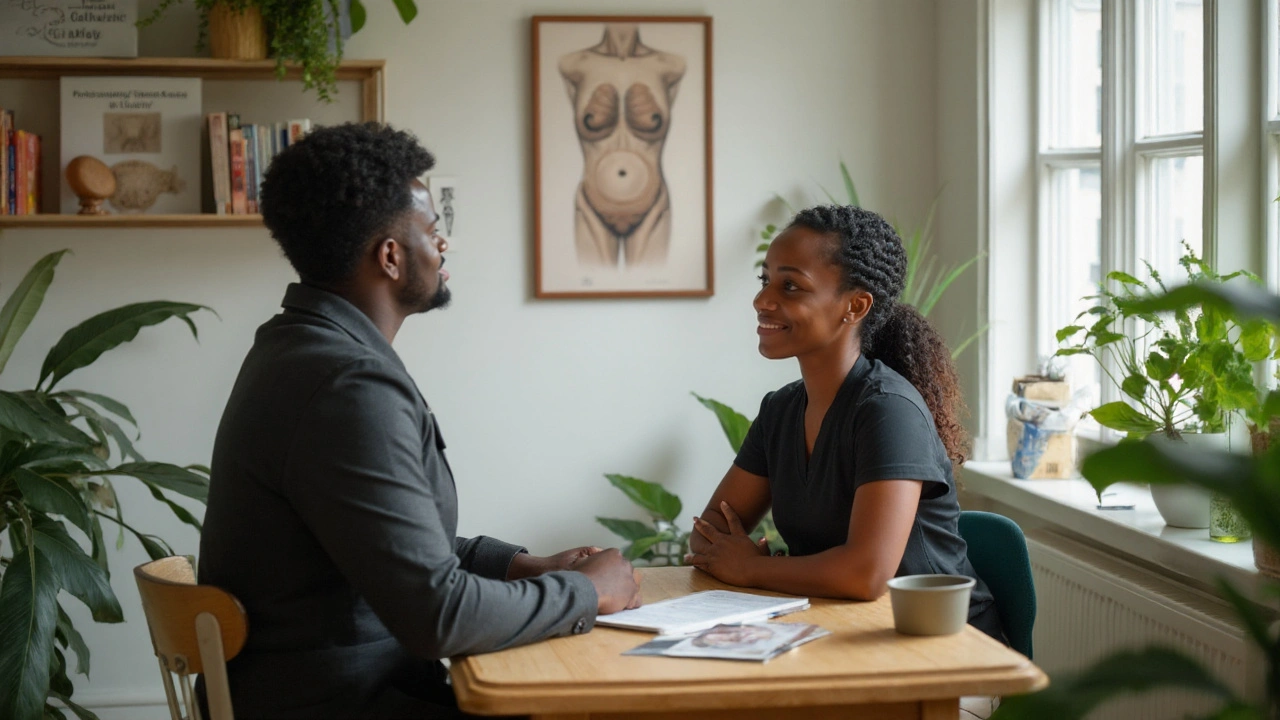Maya Abdominal Massage: Benefits, Techniques, and Safe Self‑Care (Holistic Therapy Guide 2025)

If your gut feels tight, your period keeps knocking you flat, or your lower belly just feels off, you’ve probably scrolled past quick fixes that don’t stick. There’s a quieter option with deep roots-used by midwives and bodyworkers-that aims to restore circulation and ease tension through targeted belly work. It’s not magic, and the research is early, but many people report real relief. This guide sets honest expectations and gives you practical steps so you can try it safely and see if it’s worth your time and money.
TL;DR
- Maya abdominal massage is a gentle, external belly and low-back massage rooted in Mesoamerican traditions and popularised by Dr Rosita Arvigo; it’s used to support digestion, menstrual comfort, pelvic balance, and postpartum recovery.
- What it can do: improve local blood/lymph flow, relax tight fascia and ligaments, calm the nervous system. What it can’t do: replace medical care or promise cures.
- Who it may help: people with bloating, constipation, period pain, pelvic tension, desk‑bound stiffness, and postpartum discomfort. Not suitable during the first trimester, with acute abdominal conditions, or right after surgery.
- How to try it: book a trained practitioner (ask about Arvigo or equivalent training), expect 60-90 minutes, and learn a short self‑care routine (5-10 minutes most days).
- Decision rule: give it 3 sessions over 6-8 weeks. Track symptoms. If nothing shifts, reassess or pair with pelvic floor physio, nutrition, or medical review.
What it is, how it works, and who it may help
At its core, Maya abdominal massage is a hands‑on therapy that focuses on the abdomen, pelvis, and lower back. The aim is simple: restore soft, comfortable movement in the tissues that house and support your digestive and reproductive organs. Practitioners work externally-no internal techniques-using gentle, slow strokes to encourage circulation and ease tension in the fascia and ligaments that anchor the uterus, bladder, and intestines.
The modern method most people encounter traces to Dr Rosita Arvigo, a naprapath who learned from the Belizean healer Don Elijio Panti and blended traditional teachings with soft‑tissue techniques. You’ll hear it called the Arvigo Techniques of Maya Abdominal Therapy, or just ATMAT. You don’t need to buy into mythology to get the logic: many abdominal complaints feel worse when everything is tight and still; gentle movement and blood flow tend to help.
How might it work? Three channels make sense:
- Circulation and lymph: slow, directed strokes bring warmth and blood to the belly, which may help with motility and tissue repair.
- Fascial release: the connective tissue web can get sticky; easing that can reduce pulling on the organs and ligaments in the pelvis.
- Nervous system calming: the vagus nerve and gut talk constantly. Relaxation lowers threat signals and can soften cramps and spasm.
Who turns to it? People dealing with bloating and constipation; crampy, heavy periods; a feeling of pelvic congestion; and post‑pregnancy discomfort. Desk workers who sit all day often notice their belly feels braced and shallow. Runners get bound up in the hip flexors and lower belly. As a dad in Brisbane who spends long hours writing and shuttling Lachlan to weekend sport, I first tried it after a stretch of stubborn bloating and a constant low‑back tug. The mix of practitioner work and a short at‑home routine loosened that braced feeling I didn’t realise I was carrying.
What does the evidence say? It’s early and mixed, but not empty:
- Constipation and bloating: multiple small trials and reviews report that abdominal massage can improve stool frequency and reduce discomfort in functional constipation. A 2011 systematic review in Complementary Therapies in Clinical Practice and later trials show benefits in some patients.
- Menstrual pain: manual therapy-including gentle visceral work-shows promise for primary dysmenorrhea in small randomized studies (e.g., Journal of Bodywork & Movement Therapies, 2018-2019). Effects vary, and methods differ.
- Chronic pelvic pain: pelvic‑oriented manual therapy is supported by low‑to‑moderate quality evidence for symptom relief in some people (Pain Physician, 2012; Women and Birth, 2020 reviews). Protocols vary, so results aren’t one‑size‑fits‑all.
This isn’t drug‑trial‑level evidence, and claims about “repositioning a tilted uterus” don’t have strong proof. Still, the mechanisms-circulation, fascia, and nervous system tone-are reasonable, and the risk is low when done properly.
Safety matters. Avoid sessions when:
- You’re in the first trimester of pregnancy, have a confirmed or suspected pregnancy with risk factors, or have an IUD and are experiencing unusual pain or bleeding (get medical advice first).
- You’re in the first 6 weeks after abdominal or pelvic surgery (or until your surgeon clears you).
- You have an acute abdominal condition (appendicitis, active inflammatory bowel disease flare, fever, unexplained severe pain, hernia, or abdominal aortic aneurysm history-seek medical care).
- You’re on active treatment for abdominal or pelvic cancers (consult your oncology team before any bodywork).
Second and third trimester pregnancy work is typically modified and very gentle, and some practitioners are trained in prenatal care. Always disclose your health history. If anything hurts or feels wrong, stop and speak up.
What you should expect to feel: warmth, softening, easier belly breathing, maybe a gentle urge to use the bathroom. A day or two of mild soreness can happen, like after stretching. What you shouldn’t feel: sharp pain, lasting nausea, or worsening symptoms. Those are reasons to pause and check in with a clinician.
Bottom line: credible overlap between theory and lived experience, modest early evidence, low risk when adapted to the person. The way to make it practical is to combine a few professional sessions with a simple home routine and track what changes for you.

How to try it safely: finding a practitioner and an at‑home routine
If you’ve decided to test it, give yourself a fair window: three sessions over 6-8 weeks plus consistent self‑care. That’s enough time to know if the needle is moving without over‑committing.
Finding the right practitioner
- Training: ask if they’re trained in Arvigo or a comparable abdominal/pelvic manual therapy. Experience with pelvic health and digestive complaints matters more than brand names.
- Scope and safety: they should take a thorough history (menstrual, digestive, surgical), explain what they’ll do, and adapt pressure. External work only unless they’re also a licensed pelvic floor physio and you consent to that scope.
- Professional standing (Australia): look for membership with Massage & Myotherapy Australia or the Association of Massage Therapists. In Australia, massage isn’t AHPRA‑registered; ask about insurance and first aid certification.
- Referrals: if you have pelvic floor symptoms (leaking, heaviness), ask if they coordinate with a pelvic health physiotherapist. Team care helps.
- Comfort: you should feel heard. If you don’t, switch. Abdominal work is intimate; rapport matters.
What a session looks like
- Time: 60-90 minutes. First visits are usually longer.
- Flow: history, gentle palpation of the belly and low back/sacrum, slow strokes toward the centerline and up toward the heart, with breath cues. You stay draped; only the belly/low back are uncovered.
- Education: you’re taught a short self‑massage to do at home between sessions, along with simple lifestyle touches (warmth, hydration, bowel habits).
Costs (Australia, 2025): expect AUD $110-$160 for 60 minutes and $150-$220 for 90 minutes in most cities; specialist first consults can run $180-$250. Health fund rebates depend on your extras cover and the therapist’s provider status. Call ahead and ask.
How many sessions? A common plan is three visits spaced 2-3 weeks apart, then reassess. Some people book monthly for maintenance. For period pain, time one session in the late luteal phase (about a week before bleeding) and one in the early follicular phase (after bleeding) to compare effects.
At‑home routine (5-10 minutes, most days)
Stay gentle. You’re encouraging movement, not forcing it. If you’re new, start with 3 minutes and build up.
- Set up: lie on your back with knees bent and feet flat. Place a pillow under your knees. Breathe into your belly for 5 slow breaths.
- Warm hands: rub your hands together. Place them flat over your navel, hold for 30 seconds, and feel the rise and fall of your breath.
- Clockwise circles: using your finger pads, make slow circles around your navel in a clockwise direction (the way your colon moves). Light‑to‑moderate pressure that feels good. Two minutes.
- Sweep toward the heart: place hands on the lower left belly and sweep diagonally up toward the right ribs, then across and down toward the left hip. Think of moving fluid, not pushing organs. One minute.
- Lower belly lift: place your fingertips just above the pubic bone and gently draw the lower belly up toward the navel on an exhale. Release on inhale. Ten slow reps.
- Side softening: with one hand on your side belly below the ribs, sink in gently on an exhale, hold 3 seconds, and melt out. 5-8 spots per side.
- Sacral circles: roll onto your back with a small folded towel under the sacrum (base of the spine). Make tiny pelvic tilts as you breathe for a minute.
- Finish: place hands over the belly again, take five slow breaths, and notice what changed.
When to skip self‑massage
- During the first trimester of pregnancy or if you might be pregnant.
- During heavy bleeding days if you get dizzy or cramp more (many people wait until flow lightens).
- With fever, acute belly pain, hernia, new unexplained symptoms, or soon after surgery (get medical clearance).
Pre‑session checklist
- Eat light for 1-2 hours before.
- Empty your bladder.
- Bring notes on your cycle, bowel habits, and pain patterns (simple is fine).
- Wear comfortable clothing; you’ll likely undress to undergarments and be draped.
- Set your aims: less bloating? fewer cramps? smoother bowel movements? Pick two and track them.
After‑care
- Hydrate and stay warm (a wheat bag on the belly feels great).
- Light movement: an easy walk or some hip circles keep things flowing.
- Note changes for 48 hours (stool form, cramp intensity, sleep, mood).
- If you feel sore, shorten the next at‑home session and be gentler.
Simple decision rule to measure progress
- Week 0: write baseline notes-Bristol stool type (aim for 3-4), average daily bloating (0-10), worst period cramp (0-10), and any pelvic heaviness.
- Weeks 2-8: one session every 2-3 weeks + 5-10 minutes self‑care most days.
- Week 8: if your main scores shift by 30% or more (e.g., cramps 7→4, bloating 6→3), it’s working. If not, add or swap: pelvic floor physio, GI dietitian (FODMAP guidance), sleep/stress tweaks, or speak to your GP for further assessment.
Common mistakes
- Going too hard, too fast. Gentle and frequent beats forceful and rare.
- Expecting it to fix everything. Pair it with bowel habits (don’t rush the toilet), hydration, soluble fibre, and movement.
- Skipping history. Your practitioner needs to know about IUDs, surgeries, endometriosis, or prolapse.

Scenarios, comparisons, FAQs, and next steps
How it fits different goals
- Period pain: start 1-2 weeks before your period. Combine with heat, magnesium (if appropriate for you), and movement on crampy days. Track pain across two cycles.
- Constipation‑dominant IBS: practice the clockwise routine daily. Pair with a regular toilet time after breakfast, a small footstool to raise your knees, and adequate soluble fibre (oats, kiwi, psyllium if tolerated).
- Postpartum (after medical clearance): very gentle belly contact can help you reconnect with breath and relax bracing. Add pelvic floor physio for tailored rehab.
- Desk‑bound stiffness: set a timer for 2 minutes of belly breathing and side softening mid‑afternoon. Add hip flexor stretches and a short walk.
- Endometriosis: gentle work may ease tension, but it won’t treat endometrial lesions. Coordinate with your specialist and a pelvic physio; go slow on tender days.
Comparison at a glance
| Option | What it focuses on | Best for | Evidence snapshot | Notes |
|---|---|---|---|---|
| Maya/Arvigo abdominal massage | Gentle external belly + low back; circulation, fascia, breath | Bloating, constipation, period discomfort, postpartum tension | Small trials support abdominal massage for constipation; mixed but promising for cramps | Teaches self‑care; low risk when adapted |
| General remedial/relaxation abdominal massage | Broader soft‑tissue work; relaxation | Stress‑related belly tension, mild discomfort | General massage evidence supports stress and pain relief | Easier to find; depends on therapist skill |
| Visceral manipulation (osteopathic) | Specific organ‑mobility techniques | Selected chronic pain and motility issues | Case series and small RCTs; mixed results | More technical; choose experienced clinicians |
| Pelvic floor physiotherapy | Internal/external pelvic assessment, rehab, biofeedback | Pelvic pain, prolapse, incontinence, postpartum recovery | Strong clinical support for targeted conditions | Often the best first stop for pelvic symptoms |
Mini‑FAQ
Is it only for women? No. Anyone with a belly can benefit. Men with bloating, constipation, or lower‑back tension often feel relief. The techniques adjust to the person.
Can it help fertility? No one can promise that. Some people trying to conceive report better cycles and less pelvic tension. Think of it as creating better local conditions-blood flow, relaxed tissues-within a broader plan guided by your doctor.
I have an IUD. Is it safe? Many practitioners work gently around an IUD, but you should confirm with your GP and your therapist. Avoid deep pressure over the uterus and stop if you feel crampy or unwell.
Does it “reposition a tilted uterus”? Uterine position varies a lot. There’s no solid evidence that manual therapy changes position long‑term. What often improves is how the surrounding tissues feel-less tugging and more ease-which can change symptoms.
When will I feel a difference? Some feel lighter after session one; many notice clearer changes after 2-3 sessions plus consistent home practice. Track two or three metrics so you’re not guessing.
Can I do it during my period? Light touch is fine for many, but if you cramp more or feel faint, wait until flow eases. Heat and breathwork are good stand‑ins on heavy days.
Is it painful? It shouldn’t be. Mild tenderness is normal; sharp pain is not. Tell your therapist and back off pressure.
Is this the same as tummy massage at a spa? Not really. Spa work can relax you, but this approach is slower, more targeted, and usually includes home education.
Risks and red flags
- Stop and seek medical care for severe or worsening abdominal pain, fever, unexplained weight loss, blood in stool, black tarry stool, vomiting blood, or new urinary retention.
- If you’re pregnant or might be, get clearance before any belly work.
- After surgery, wait until your surgeon says scars are healed enough for gentle work.
Next steps
- Pick two goals (e.g., “reduce cramps 7→4” and “have one easy bowel movement daily”).
- Book three sessions with a trained practitioner and learn the home routine.
- Do 5-10 minutes at home most days; keep notes in your phone.
- Reassess at week 8. If it helps, keep it. If not, pivot: pelvic floor physio, GI dietitian, GP work‑up.
Troubleshooting
- If you feel bloated after: shorten your next home session, lighten pressure, and add a 10‑minute walk after meals.
- If cramps flare: avoid deep lower‑belly work right before your period; focus on breath, heat, and sacral circles instead.
- If constipation isn’t budging: check fibre type (too much insoluble can backfire), add warm fluids in the morning, and keep your feet elevated on the toilet.
- If anxiety spikes: keep one hand on the belly and one on the chest and slow your exhale to twice the length of your inhale; let the massage be secondary to breath.
A quick note on language: you’ll see different labels out there. Some clinics stick to “abdominal therapy,” some to “Arvigo,” others say “visceral massage.” The heart of it is the same-gentle, attentive contact that helps your belly move and your nervous system settle. Whether you’re in Brisbane like me or halfway across the world, the principles travel well: go gentle, be consistent, and measure what matters to you.
If you remember only one thing, let it be this: try Maya abdominal massage as a structured experiment-three sessions, daily five‑minute self‑care, two clear goals, and honest tracking. That’s how you’ll know if this hidden gem is worth a spot in your toolkit.





